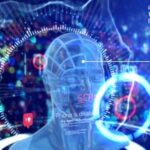7 Risks of Artificial Intelligence
Table of Contents
Artificial intelligence (AI)—the shimmering promise of a future wherein machines suppose, examine, or even surpass human talents—unexpectedly permeates each facet of our lives. From the customized commercials on our screens to the algorithms powering self-driving cars, AI whispers its transformative magic in seemingly harmless ways. But even as we are surprised at its ability, a shadow lurks at the brink of this bright future—the specter of unforeseen risks.
This blog is not a dystopian prophecy but an essential communication about the seven capacity pitfalls we must navigate as we include the AI revolution. By acknowledging and addressing those dangers, we can ensure that AI will become a pressure for suitableness, paving the way for a destiny wherein human beings and machines collaborate harmoniously.

1. Algorithmic Bias: When Code Reflects Prejudice
Imagine a hiring set of rules that inadvertently favors precise genders or ethnicities, perpetuating real-world inequalities. This, sadly, is not fiction. Take the case of Amazon’s 2018 hiring algorithm, designed to streamline candidate choice but, in the long run, to disadvantage female applicants. Algorithmic bias is not a remote incident; it’s a systemic hazard lurking in facial popularity software that misidentifies minorities or newsfeeds that sell echo chambers, amplifying extremist perspectives.
2. Job Displacement: The Looming Spectre of Automation
As AI automates tasks from guide exertions to white-collar professions, anxieties around task displacement rise. While a few roles will undergo transformation, mass unemployment’s destiny is not inevitable. Reskilling and upskilling projects emerge as vital, equipping individuals with the abilities they need to thrive in an AI-driven economic system. This includes fostering creativity, crucial thinking, and emotional intelligence—unique human traits that remain irreplaceable using machines.
3. Privacy Erosion: When Big Brother Becomes Big Data
AI flourishes on information, with extensive oceans of information fueling its algorithms. But when data collection becomes omnipresent, privacy concerns rightfully bubble up. Imagine AI-powered surveillance systems monitoring each flow or facial popularity software used for mass identification without consent. Protecting our virtual selves becomes paramount, disturbing robust data privacy frameworks and transparent AI development practices.
4. Algorithmic Warfare: The Weaponization of Intelligence
The next day’s autonomous guns, powered with AI’s aid, increase chilling ethical questions. Imagine drones making life-or-death choices on the battlefield or cyberattacks escalating into uncontrollable digital wars. The dangers of weaponized AI aren’t simply futuristic; the hands-on race has already started. International collaboration and strict regulations are urgently needed to prevent AI from becoming a destructive device.

5. Deepfakes and Disinformation: Reality Under Siege
Imagine a world where video and audio can be seamlessly manipulated, creating plausible but fabricated narratives. Deepfakes, powered by AI, pose an extreme danger to accept as accurate with social cohesion. False records disguised as facts spread like wildfire, doubtlessly influencing elections, swaying public opinion, and even eroding our idea of goal truth. Media literacy and truth-checking projects are essential weapons in this struggle in opposition to virtual deception.

6. Existential Threat: When Machines Surpass Us
While the idea of superintelligent AI posing an existential danger may also seem like technological know-how fiction, it is a subject voiced by prominent figures like Elon Musk and Stephen Hawking. The ability of AI to surpass human intelligence and redefine the nature of cognizance demands cautious attention. Ensuring alignment between human values and AI desires becomes critical, stopping a future in which device intelligence surpasses our control.
7. The Black Box Problem: When Transparency Gets Clouded
The “black field” nature of many AI algorithms—their selection-making methods shrouded in obscurity—fosters distrust and hinders accountability. Imagine scientific diagnoses introduced by AI without explanation or self-sufficient automobiles making crucial choices without transparent reasoning. Explainable AI initiatives, encouraging transparency and human oversight, are essential to making specific responsible improvements and instilling public consideration in this effective generation.

Facing the Labyrinth with Courage and Foresight
As we navigate the labyrinth of AI advancements, one aspect is prominent: fear and a state of no activity are not options. Instead, we should embrace a spirit of responsible improvement guided by ethical ideas and unwavering dedication to human well-being. This method addresses algorithmic bias, investing in upskilling projects, strengthening information privacy measures, regulating AI conflict, combating disinformation, and prioritizing transparency in AI development.
The future of AI isn’t a preordained script; it is a tale ready to be written. By recognizing the dangers and actively shaping its improvement, we can ensure that AI becomes a pressure for right, propelling humanity closer to a destiny of collaboration, development, and shared prosperity. Let’s journey into this new frontier with courage, foresight, and an unwavering dedication to constructing a future wherein human beings and machines thrive together.
FAQs:
How can we cope with algorithmic bias in AI structures?
- Diverse datasets and inclusive improvement groups are critical to lessening bias.
- Regular audits and checking out can identify and mitigate bias in current structures.
- Transparency and explainability of AI choices permit the detection and correction of preconceptions.
What can people do to assemble process displacement processes because of AI?
- Focus on growing capabilities that supplement AI: creativity, essential questioning, and emotional intelligence.
- Engage in lifelong studying and upskilling tasks to stay adaptable in a changing task market.
- Explore new career paths that leverage human-gadget collaboration.
How are we able to protect privacy in an AI-driven international?
- Advocate for solid information privacy guidelines and responsible fact-collection practices.
- Be aware of personal information sharing and use privacy-improving gear.
- Support projects that promote transparency and responsibility in AI development.
What can be achieved to save you from the weaponization of AI?
- International collaboration and treaties are needed to alter the AI conflict.
- Ethical tips and oversight mechanisms are required to govern AI development.
- Public cognizance and debate are essential to elevating the stakes for the misuse of AI.
How can we combat deepfakes and disinformation?
- Media literacy initiatives can help human beings seriously compare online content.
- AI-powered gear for detecting and flagging deepfakes is being evolved.
- Support reality-checking organizations and promote accountable journalism.
What steps can we take to confirm AI remains aligned with human values?
- Involve numerous stakeholders in AI development, including ethicists and social scientists.
- Prioritize transparency and explainability in AI structures.
- Develop mechanisms for human oversight and manipulation of AI selections.











